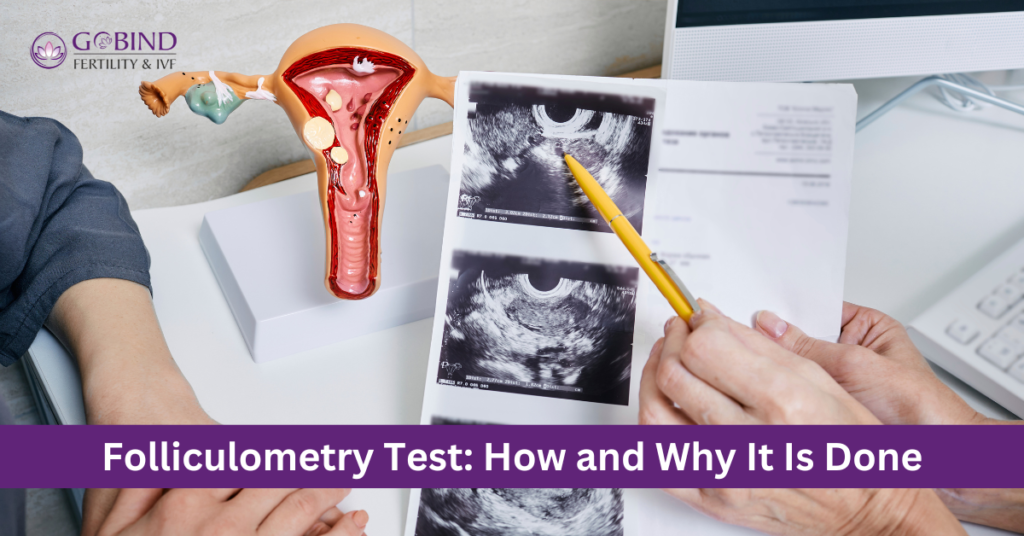Folliculometry Test: How and Why It Is Done

What Is a Folliculometry Test?
Folliculometry is an ultrasound-based diagnostic procedure used to monitor the growth and development of ovarian follicles. It is commonly performed in women undergoing fertility treatments or those trying to conceive naturally. This test helps determine the best time for conception by tracking ovulation.
In India, folliculometry plays a crucial role in fertility assessments and treatments. Here are some key statistics and findings related to its application:
Antral Follicle Count (AFC) in Indian Women:
- A study comparing fertile and infertile Indian women found that 86.7% of fertile participants had an AFC greater than 10, whereas 60% of subfertile women had an AFC of 10 or less.
Transvaginal Sonography (TVS) vs. Transabdominal Sonography (TAS):
- Research indicates that TVS offers superior visualization of ovarian and follicular anatomy compared to TAS. Specifically, 80.8% of cases achieved good follicle visualization with TVS, in contrast to 35.6% with TAS.
Follicular Development in Stimulated Cycles:
- In stimulated cycles, ultrasound monitoring revealed that 56% of women developed a single dominant follicle, 30% had two follicles, 12% had three, and 2% had four follicles.
Why Is a Folliculometry Test Done?
A folliculometry test is essential for:
- Tracking Ovulation: It helps detect the presence and growth of mature follicles, indicating the timing of ovulation.
- Fertility Treatments: It is crucial for treatments like intrauterine insemination (IUI) and in vitro fertilization (IVF) to ensure proper egg maturation before egg retrieval or insemination.
- Assessing Ovarian Function: It evaluates the ovarian response to fertility medications and hormonal imbalances.
- Identifying Ovulation Disorders: Conditions like polycystic ovary syndrome (PCOS) and anovulation can be diagnosed through folliculometry.
- Optimizing Natural Conception: Couples trying to conceive naturally can use this test to time intercourse for higher chances of pregnancy.
- Detecting Luteal Phase Defects: It helps determine if the luteal phase is sufficient for implantation and pregnancy maintenance.
How Is a Folliculometry Test Performed?
The test involves a series of transvaginal ultrasounds conducted over multiple days in a menstrual cycle:
- Baseline Scan: Performed on day 2 or 3 of the menstrual cycle to check for any ovarian cysts or abnormalities.
- Follicle Monitoring: Ultrasounds are performed every 2–3 days starting from day 9 or 10, depending on cycle length, to track follicular growth.
- Ovulation Detection: When a follicle reaches 18–25 mm in size, ovulation is expected soon. The doctor may advise ovulation-triggering injections if needed.
- Post-Ovulation Scan: A final scan after ovulation confirms follicle rupture and corpus luteum formation, which is essential for implantation and pregnancy.
Preparation for the Test
- No special preparation is required.
- Drinking plenty of water before the scan can help if an abdominal ultrasound is used, but for transvaginal ultrasound, an empty bladder is recommended.
- Avoiding intercourse before the test may be advised in some cases.
- Keeping a record of past menstrual cycles can assist in better scheduling of the test.
Risks and Considerations
- The procedure is safe and non-invasive with no known side effects.
- Women with irregular cycles may need additional scans.
- Those undergoing fertility treatments might need hormonal support based on scan results.
- Repeated ultrasound exposure is considered safe, but emotional stress from repeated scans should be managed.
Benefits of Folliculometry
- Higher chances of conception by accurately predicting ovulation.
- Reduced uncertainty for couples trying to conceive.
- Better fertility treatment outcomes by optimizing egg retrieval timing.
- Identification of potential fertility issues early on, allowing for timely intervention.
Cost of Follicular Monitoring in India
- The cost for each follicular monitoring session in India varies by region and facility, typically ranging from ₹800 to ₹2,000.
Conclusion
Folliculometry is a vital tool in fertility assessment and treatment, helping women track ovulation and improve their chances of conception. Whether used for natural conception or assisted reproductive techniques, it provides valuable insights into ovarian function and reproductive health. Closely monitoring follicle growth, increases the likelihood of a successful pregnancy while offering guidance on necessary medical interventions.
